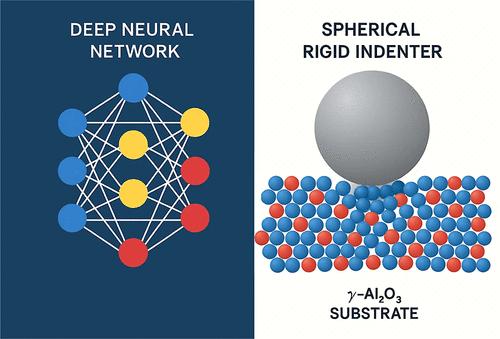Friction Mechanisms of γ-Al2O3 Under Nanoindentation–Scratch Coupling: A Deep Neural Network Potential Approach
IF 3.2
3区 化学
Q2 CHEMISTRY, PHYSICAL
引用次数: 0
Abstract
This study constructs and validates a deep neural network potential with quantum-level accuracy for γ-Al2O3, achieving root-mean-square errors of 1.2 meV/atom for energy and 19 meV/Å for force. Based on this potential, nanoindentation-scratch simulations at three indentation depths are performed to investigate the evolution of elasticity, creep, and viscoplasticity. Hertzian fitting yields an elastic modulus of 317.4–322.4 GPa, which closely agrees with experimental measurements. Frictional analysis reveals that the normal force stabilizes into a plateau, while the friction coefficient exhibits a nonlinear increase, governed respectively by the real contact area and the atomic-scale shear strength spectrum. The normalized load Π = Ff/Nc indicates that the mean interfacial shear strength remains nearly constant with depth, whereas the amplitude of its fluctuations increases by a factor of 3. These findings elucidate the synergistic roles of contact area control and shear spectrum broadening in ceramic interfacial friction, providing quantitative guidance for friction reduction strategies that integrate surface texturing and interfacial chemistry, and establishing a computational foundation for large-scale data-driven materials design.

纳米压痕-划痕耦合下γ-Al2O3的摩擦机制:深度神经网络电位方法
本研究构建并验证了具有量子级精度的γ-Al2O3深度神经网络电位,能量的均方根误差为1.2 meV/原子,力的均方根误差为19 meV/Å。基于这种潜力,在三种压痕深度下进行了纳米压痕-划痕模拟,以研究弹性,蠕变和粘塑性的演变。赫兹拟合得到的弹性模量为317.4 ~ 322.4 GPa,与实验结果非常吻合。摩擦分析表明,法向力趋于平稳,摩擦系数呈非线性增长,分别受实际接触面积和原子尺度剪切强度谱的控制。归一化荷载Π = Ff/Nc表明,平均界面抗剪强度随深度的变化几乎保持不变,而其波动幅度增加了3倍。这些发现阐明了接触面积控制和剪切谱展宽在陶瓷界面摩擦中的协同作用,为结合表面织构和界面化学的摩擦减少策略提供了定量指导,并为大规模数据驱动的材料设计奠定了计算基础。
本文章由计算机程序翻译,如有差异,请以英文原文为准。
求助全文
约1分钟内获得全文
求助全文
来源期刊

The Journal of Physical Chemistry C
化学-材料科学:综合
CiteScore
6.50
自引率
8.10%
发文量
2047
审稿时长
1.8 months
期刊介绍:
The Journal of Physical Chemistry A/B/C is devoted to reporting new and original experimental and theoretical basic research of interest to physical chemists, biophysical chemists, and chemical physicists.
 求助内容:
求助内容: 应助结果提醒方式:
应助结果提醒方式:


